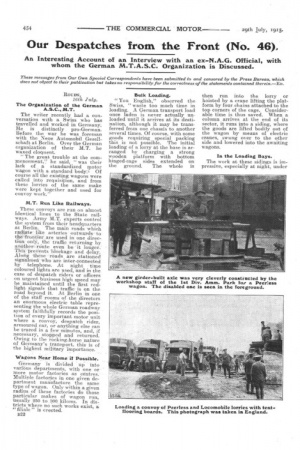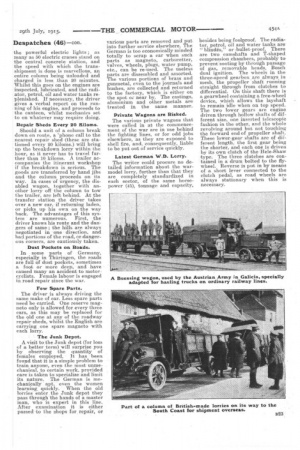Our Despatches from the Front (No. 46)2
Page 4

Page 5

If you've noticed an error in this article please click here to report it so we can fix it.
An Interesting Account of an Interview with an ex-N.A.G. Official, with whom the German M.T.A.S.C. Organization is Discussed.
These messages from Our Own Special Correspondents have been submitted to and censored by the Press Bureau, which does not object to their publication but takes no responsibility for the correctness of the statements contained therein.—ED.
Rou-Etc,
16111, July.
The Organization of the German A.S.C., M.T.
The writer recently had a conversation with a Swiss who has travelled and worked in Germany. He is distinctly pro-German. Before the war he was foreman with the Xeue Automobil Gesellschaft at Berlin. Over the German organization of their M.T. he waxed eloquent.
"The great trouble at the coramencement,'? he said, "was their lack of a .standardized motor wagon with a standard body-1;Of course all the existing wagons were called into requisition, and from these lorries of the same make -were kept together and used for convoy work."
M.T. Run Like Railways.
These convoys are run on almost identical lines to the State railways. Army M.T. experts control the systein from their headquarters at Berlin. The main roads -which raliate like arteries• outwards to the 'frontier are used in one direction only, the traffic -returning by a0Pther:;Edute even be it longer.' This Prevents blockage and delay. Alofig these 'reads are Stationed signalmen who 'arC inter-connected by telephone. At night -time coloured lights are used, and in the case of despatch riders or officers on urgent business high speed may be maintained until the first redlight signals that traffic is on the road beyond it. At Berlin in one of the staff rooms of the directors an enormous electric table representing the whole German roadway system faithfully records the position of every important motor unit where a convoy, despatch rider, armoured car, or anything else can be traced in a few minutes, and, if necessary, stopped and returned. Owing to the rocking,horse nature of Germany's transport, this is of the highest military importance.
Wagons Near Homeif -Possible.
Germ any is divided up into varibus departments, with one or more motor factories as centre.s.Multiple factories in one given department manufacture the same type of wagon. Only within a given radius of these factories do those particular makes of wagon run, usually 250 to 300. kiloms. In districts where no such works exist, a " finale " is erected.
Bulk Loading.
"You English," observed the Swiss, "waste too much time in loading. A German transport load once laden is never actually unloaded until it arrives at its destination, although it may be transferred from one chassis to another several times. Of course, with some goods requiring special packing this is not possible. The initial loading of a lorry at the base is arranged by charging a strong wooden platform with bottom hinged-cage sides extended on the ground. The whole is then run into the lorry or hoisted by a crane lifting the platform by four chains attached to the top corners of the cage. Considerable time is thus saved. When a column arrives at the end of its sector, it runs into a siding, where the goods are lifted bodily out of the wagon by means of electric cranes, swung over to the other side and lowered into the awaiting wagons.
In the Loading Bays.
The work at these sidings is impressive, especially at night, under
the powerful electric lights ; as many as 50 electric cranes stand on the central concrete station, and the speed with which the transshipment is done is marvellous, an entire column being unloaded and charged in less than 20 minutes. Whilst this goes on the engines are inspected, lubricated, and the radiator, petrol, oil and water tanks replenished. If necessary, the driver gives a verbal report on the running of his engine, and proceeds to the canteen, whilst mechanics set to on whatever may require doing.
Repair Sheds Every 20 Kiloms.
Should a unit of a column break down en route, a 'phone call to the nearest repair shed (these are stationed every 20 kilams.) will bring ' up the breakdown lorry within the hour, as it never has to travel further than 10 kilorns. A trailer accompanies the itinerant workshop if the breakdown is serious. The goods are transferred by hand jibs and the column proceeds on its way. In cases of urgency, the disabled wagon, together with another lorry off the column to tow the trailer, are left behind. At the transfer station the driver takes over a new car, • if returning laden, or picks up his own on the way back. The advantages of this system are numerous. First, the driver knows his route and the dangers of same ; the hills are always negotiated in one direction, and bad portions of the road, or dangerous corners, are cautiously taken.
Dust Pockets on Roads.
In some parts of Germany, especially in Thuringen, the roads are full of dust pockets, sometimes a feat or more deep, and have caused many an accident to motor • cyclists. Female labour is engaged in road repair since the war.
Few Spare Parts.
The driver is always driving the same make of car. Less spare parts need be carried. One reserve magneto only is allowed for every three cars, as this may be replaced for the old one at any of the roadway repair sheds, whilst the English are carrying one spare magneto with each lorry.
The Junk Depot.
A visit to the Junk depot (for loss of a better term) will surprise you by observing the quantity of females employed. It has been found that it is a simple problem to train anyone, even the most =mechanical, to certain work, provided care is taken to specialize and limit its nature. The German is mechanically ' apt, even the women learning. quickly. • When the old lorries enter the Junk depot they pass through the hands of a master man, who is expert in this line. After examination it is either passed to the shops for repair, or various parts are removed and put into further service elsewhere. The German is too economically minded totally to scrap a car when such parts as magneto, carburetter, valves, wheels, plugs, water pump, etc., can be re-used. The useless parts are dissembled and assorted. The various portions of brass and gunmetal, even to the journals and bushes, are collected and returned to the factory, which is either on the spot of near by. The castings, aluminium and other metals are treated in the same manner.
Private Wagons are Risked.
The various private wagons that were called in at the .commencement of the war are in use behind the fighting lines, or for odd jobs elsewhere, as they are exposed to shell fire, and, consequently, liable to be put out of service quickly.
Latest German W.D. Lorry.
The writer could procure no detailed information about the warmodel lorry, further than that they are completely standardized in each sector, of the same horsepower (45), tonnage and capacity,
besides being foolproof. The radiator, petrol, oil and water tanks are " blindes," or -bullet-proof. There are two camshafts and T-shaped compression chambers, probably to prevent sooting by through passage of gas, removable heads, Bosch dual ignition. The wheels in the three-speed gearbox are always in mesh, the propeller .shaft running straight through from clutches to differential. On this shaft there is a gearwheel containing a free-wheel device, which allows the layshaft to remain idle when on top speed. The two lower gears are engine driven through hollow shafts of different size, one inserted telescopic fashion in the other, and the whole revolving around but not touching the forward end of propeller shalt. These lower-gear shafts are of different length, the first gear being the shorter, and each one is driven by its own clutch of the Hele-Shaw type. The three clutches are contained in a drum bolted to the flywheel. Reverse is put in by means of a short lever connected to the clutch pedal, as road wheels are always stationary when this is necessary.






















